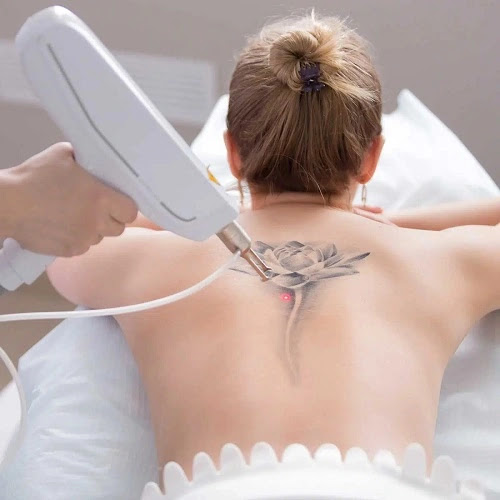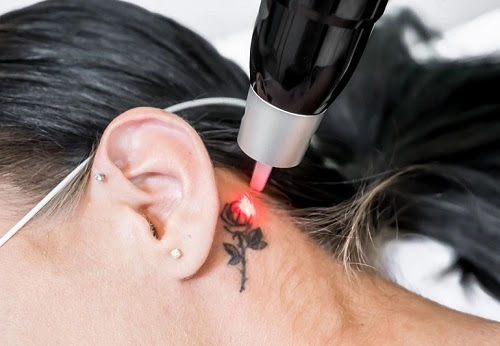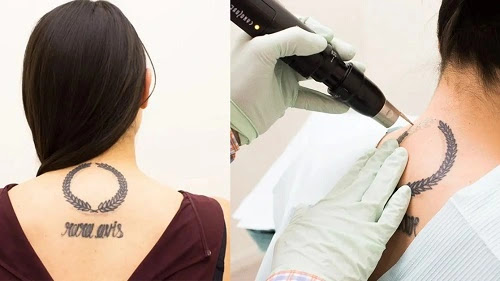Overview 💓
Tattoo removal is a procedure done to try to remove an unwanted tattoo. Common techniques used for tattoo removal include laser surgery, surgical removal, and dermabrasion.
Tattoo ink is placed under the top layer of skin. That makes tattoo removal more complicated and expensive than the original tattoo application.
If you are interested in tattoo removal, consult a skin doctor (dermatologist) about your options. Do not try to remove the tattoo on your own. DIY tattoo removal creams and other home treatments are unlikely to be effective and may cause skin irritation or other reactions.
Credit: PlatinumTattooStudioBali
because it’s done
You may consider tattoo removal if you regret a tattoo or are dissatisfied with the appearance of your tattoo. Perhaps the tattoo has faded or become blurry, or you decide that the tattoo does not fit your current image.
Tattoo removal may also be important if you develop an allergic reaction to the tattoo or other complications, such as an infection.
risks
Scarring is likely after most types of tattoo removal. Infection or skin discoloration is also possible.
how do you prepare
If you are considering tattoo removal, consult a dermatologist. He or she can explain the options for tattoo removal and help you choose the method that is likely to be most effective for your tattoo.
For example, some tattoo inks respond better to laser treatment than others. Similarly, small tattoos may be good candidates for surgical removal, while others are simply too large to remove with a scalpel.
what you can expect
Tattoo removal is often performed as an outpatient procedure under local anesthesia. Common techniques for tattoo removal include laser surgery, surgical removal, and dermabrasion.
laser surgery
Q-switched lasers, which deliver energy in a single powerful pulse, are often the treatment of choice for tattoo removal. A special type of laser, called a Q-switched Nd:YAG, can be used on darker skin to avoid changing the skin’s pigment permanently.
Before laser treatment, the skin is numbed with an injection of local anesthetic. A powerful pulse of energy is then applied to the tattoo to heat and break up the tattoo ink. Multi-colored tattoos may need treatment with multiple lasers and different wavelengths.
After the procedure, you may notice swelling and possibly blistering or bleeding. The antibacterial ointment can help promote healing. You may need several sessions to lighten the tattoo, and you may not be able to completely remove it.
surgical removal
During surgical removal, the skin is numbed with an injection of local anesthetic. The tattoo is removed with a scalpel, and the skin edges are sutured back together. After the procedure, antibacterial ointment helps promote healing.
Surgical tattoo removal is effective, but it does leave a scar and may be practical only for small tattoos.
dermabrasion
During dermabrasion, the tattooed area is usually cooled until it is numb. The tattooed skin is then sanded to deeper levels with a high-speed rotary device that has an abrasive wheel or brush. This allows the tattoo ink to seep out of the skin.
The affected area feels sore and raw for several days after the procedure. Recovery can take two to three weeks. Due to unpredictable and less effective results than laser or a combination of laser and excision, dermabrasion is not a common option.
Results
Tattoos are meant to be permanent and it is difficult to remove them completely. Some degree of scarring or variation in skin color is likely to remain, regardless of the specific method of tattoo removal.
Tattoos: Understanding the Risks and Precautions
Tattoos may be more common than ever, but don’t take the risks lightly. Understand basic safety precautions and aftercare.
You could be the proud owner of a new tattoo in a matter of hours, but don’t let the ease of the process stop you from thinking hard about permanent body art. Before getting a tattoo, make sure you know what it involves and how to reduce any potential risks.
How tattoos are made
A tattoo is a permanent mark or design made on the skin using pigments that are inserted through punctures into the top layer of skin. Typically, the tattoo artist uses a manual machine that acts like a sewing machine, with one or more needles repeatedly piercing the skin. With each prick, the needles insert tiny droplets of ink.
The process, which is performed without anesthesia, causes a small amount of bleeding and minor or potentially significant pain.
- know the risks
- a granuloma
- Open popup dialog
- granuloma
Tattoos break the skin, which means skin infections and other complications are possible, including:
Allergic reactions. Tattoo dyes, especially red, green, yellow, and blue dyes, can cause allergic skin reactions, such as an itchy rash at the tattoo site. This can happen even years after getting the tattoo.
skin infections A skin infection is possible after the tattoo.
Other skin problems. Sometimes an area of inflammation called a granuloma can form around the tattoo ink. Tattoos can also lead to keloids, raised areas caused by an overgrowth of scar tissue.
Bloodborne diseases. If the equipment used to create your tattoo is contaminated with infected blood, you can contract several blood-borne diseases, including methicillin-resistant Staphylococcus aureus (MRSA), hepatitis B, and hepatitis C.
MRI complications. Rarely, tattoos or permanent makeup can cause swelling or burning in the affected areas during magnetic resonance imaging (MRI) exams. In some cases, the pigments in the tattoo can interfere with the quality of the image.
Medication or other treatment may be needed if you experience an allergic reaction to tattoo ink or develop an infection or other skin problem near a tattoo.
make sure you’re ready
Before getting a tattoo, think about it carefully. If you’re not sure or worried you might regret it, give it more time. Don’t be pressured into getting a tattoo, and don’t get a tattoo if you’re under the influence of alcohol or drugs.
dermatologist laser tattoo removal
Choose the location of the tattoo carefully. Consider whether you want the option of hiding your tattoo under clothing. Also remember that weight gain, including weight gain during pregnancy, can distort the tattoo or affect its appearance.
Insist on safety precautions
To ensure your tattoo is applied safely, ask these questions:
Who does the tattoo? Go to a reputable tattoo studio that employs only properly trained employees. Please note that regulatory requirements and licensing standards vary from state to state. Check with your city, county, or state health department for information on local regulations and licensing.
Does the tattoo artist wear gloves? Make sure the tattoo artist washes their hands and wears a fresh pair of protective gloves for each procedure.
Does the tattoo artist use the proper equipment? Make sure the tattoo artist removes the needle and tubes from the sealed packages before the procedure begins. Pigments, trays or containers should also not be used.
Does the tattoo artist sterilize non-disposable equipment? Make sure the tattoo artist uses a heat sterilization machine (autoclave) to sterilize all non-disposable equipment between clients. Instruments and supplies that cannot be autoclaved, including drawer handles, tabletops, and sinks, should be disinfected with a commercial disinfectant or bleach solution after each use.
take good care of your tattoo
Caring for your new tattoo depends on the type and extent of work done. In general, however, you will need to:
Keep tattooed skin clean. Use plain soap and water and a gentle touch. While you shower, avoid direct jets of water on the newly tattooed skin. Pat the area dry, do not rub.
Use moisturizer. Apply a light moisturizer to the tattooed skin several times a day.
Avoid sun exposure. Keep the tattooed area out of the sun for at least a few weeks.
Avoid swimming. Stay away from swimming pools, hot tubs, rivers, lakes, and other bodies of water while your tattoo is healing.
Choose your clothes carefully. Don’t use anything that can stick to the tattoo.
Allow up to 2 weeks for healing. Do not touch any scabs, which increases the risk of infection and can damage the design and cause scarring.
If you think your tattoo might be infected or you’re concerned your tattoo isn’t healing properly, contact your doctor. If your tattoo is not what you expected and you are interested in tattoo removal, ask your dermatologist about laser surgery or other tattoo removal options.










